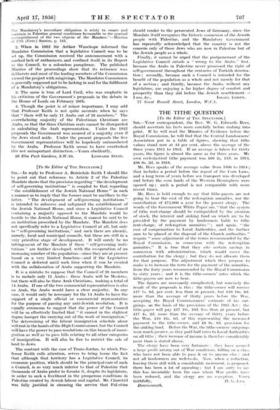THE TITHE QUESTION
[To the Editor of THE SPECTATOR.] SIR,—Your correspondent, the Rev. W. G. Edwards Rees, should ascertain his facts more carefully before rushing intm print. If he will read the Minutes of Evidence before the Royal Commission, he will find that the Central Landowners', Association put in a table of figures, showing that tithe values stand now at 44 per cent. above the average of the three years 1911 to 1913. If an average is taken for thirty years, the figtire is almost the same as for three years. My own ecclesiastical tithe payment was £66 2s. lid. in 1p13, £96 Os. 2d. in 1918.
Mr. Rees speaks of the average value from 1836 to 1914 ; that includes a period before the repeal of the Corn Laws, and a long term of years before sea transport was developed and before the corn lands of the Western Hemisphere were opened up ; such a period is not comparable with more recent times.
Mr. Rees is bold enough to say that tithe-payers are not going to bear the cost of the redemption annuities, nor the contribution of £72,000 a year for the poorer clergy. The words of the GovernMent White Paper are, "that the systein of tithe rent-charge should be extinguished by the creation of stock, the interest and sinking fund on which are to be provided by the payment by landowners liable to tithe rent-charge, of redemption annuities " ; and again. " the cost of compensation to Local Authorities, and the further sum to be placed at the disposal of the Church authorities " require " some adjustment of the terms recommended by the Royal Commission, in connexion with the redemption annuities." It is true that they cite certain savings in connexion with administration, which would cover the contribution for the clergy ; but they do not allocate thern for that purpose. The adjustment which they propose to make is to increase the term for the payment of the annuities. from the forty years recommended by the Royal Commission to sixty years ; and it is the tithe-owners' rates which the tithe-payers are now to bear.
The figures arc necessarily complicated, but concisely the result of the proposals is this : the tithe-owner will receive £17 7s. 6d. per cent. less than at present, but £10 16s. 6d. more than the average of thirty years before the War, accepting the Royal Commissioners' estimate of his out- goings, on the basis of the provisions of the 1925 Act ; the tithe-payer will pay £17 18s. lOd. less than at present, but £17 4s. 2d. More than the average of thirty years before the War, £10 16s. Od. of this representing the increased payment to the tithe-owner, and £6 6s. 8d. provision for the sinking fund. Before the War, the tithe-owners' outgoing's were much greater, as they paid half rates to Local Authorities on all tithe ; their increase of income is therefore considerably more than is stated above.
The clergy have been very fortunate ; they have secured a large profit arising out of War conditions, falling on a class who have not been able to pass it on to anyone else ; and not all landoWners are well-to-do. Now,' when a reduction, leaving them still with a considerable increment, is proposed. there has been a lot of squealing ; but I am sorry to say this- has -invariably been the case where War profits have been reduced, and the clergy are no exception. -- Yours












































 Previous page
Previous page